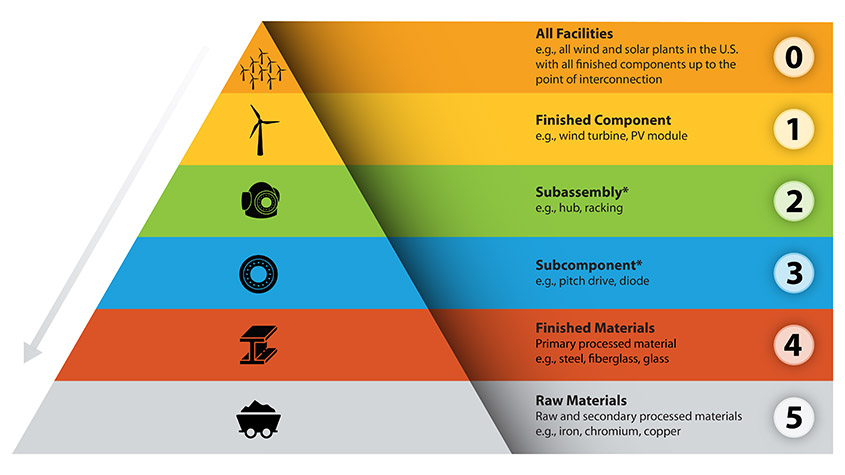REMPD: Renewable Energy Materials Properties Database
The Renewable Energy Materials Properties Database (REMPD), produced by NLR, provides a consolidated resource for identifying the type, quantity, source, and other properties of materials used by wind energy and solar power technologies.
Quick Links
Read a wind energy future scenarios report demonstrating the database’s full capabilities
With the growing demand for renewable energy, such as wind energy and solar power, the quantity of materials needed to install renewable energy facilities is also increasing. The choice of which materials to use in these facilities may be influenced by limitations of finite or shared resources, supply chain processes, or novel or improved designs that address other factors, like high costs and environmental and societal impacts.
The Energy Act of 2020 directs the Wind Energy Technologies Office and Solar Energy Technologies Office, within the U.S. Department of Energy (DOE) Office of Energy Efficiency and Renewable Energy, to produce a comprehensive database that provides the type, quantity, availability, and other properties of materials needed to construct wind and solar energy technologies.
On behalf of DOE, researchers at NLR developed the database with contributions from experts at Oak Ridge National Laboratory, Lawrence Berkeley National Laboratory, Sandia National Laboratories, and Arizona State University.
The REMPD quantifies how much and what type of materials are needed to construct wind energy and solar power devices and plants, summarizing the significant uses, availability, countries of origin, and some physical (such as thermal, electrical, and mechanical) properties for these materials.
The database and its accompanying summary report do not analyze supply chains for these materials. However, that information can be found in DOE’s complementary report, America’s Strategy To Secure the Supply Chain for a Robust Clean Energy Transition, and affiliated subreports on wind energy and solar power. In a 2023 technical report on future wind energy scenarios, NLR researchers used REMPD to evaluate how demand for certain materials compares to current domestic and global supply.
Capabilities
The REMPD includes information at multiple scales of renewable energy facility development, including:
- Wind energy and solar power plants
- Components in wind energy and solar power plants, including wind turbines and photovoltaic modules
- Subassemblies that make up components, such as a wind turbine hub
- Subcomponents—for example, diodes—that combine to form solar subassemblies
- Finished materials, such as glass and steel
- Raw materials that have yet to be altered, such as chromium and copper.

REMPD provides information on materials from large to small tiers, including wind energy and solar power plants, wind turbines and photovoltaic (PV) modules and down to the metals and man-made materials used in renewable energy technologies. Asterisks note tiers populated based on available data, which may be expanded in the future. Graphic by Nicole Leon, NLR
The database includes the following properties of wind energy and solar power materials:
- Country of origin
- Source
- Significant uses
- Projected availability
- Physical properties
- Type
- Quantity.
The REMPD can also calculate metrics for material analysis to help stakeholders understand potential material needs for wind energy and solar power development in a wide range of different deployment scenarios.
These metrics include:
- Material intensity, or the mass of material (in kilograms) needed per unit of generating capacity (in megawatts)
- Material quantity in kilograms per year
- Quantity of material needed to satisfy a given deployment scenario as a percent of global production.
Access
An open-source version of outputs from the REMPD is accessible on DOE’s OpenEI platform. Users can also download a publicly available version of the database contents to their own server.
To learn more about how to use the database—including definitions for the content, labels, properties, and metrics included—read the Renewable Energy Materials Properties Database: Summary.
Contact
Share
Last Updated Dec. 7, 2025
